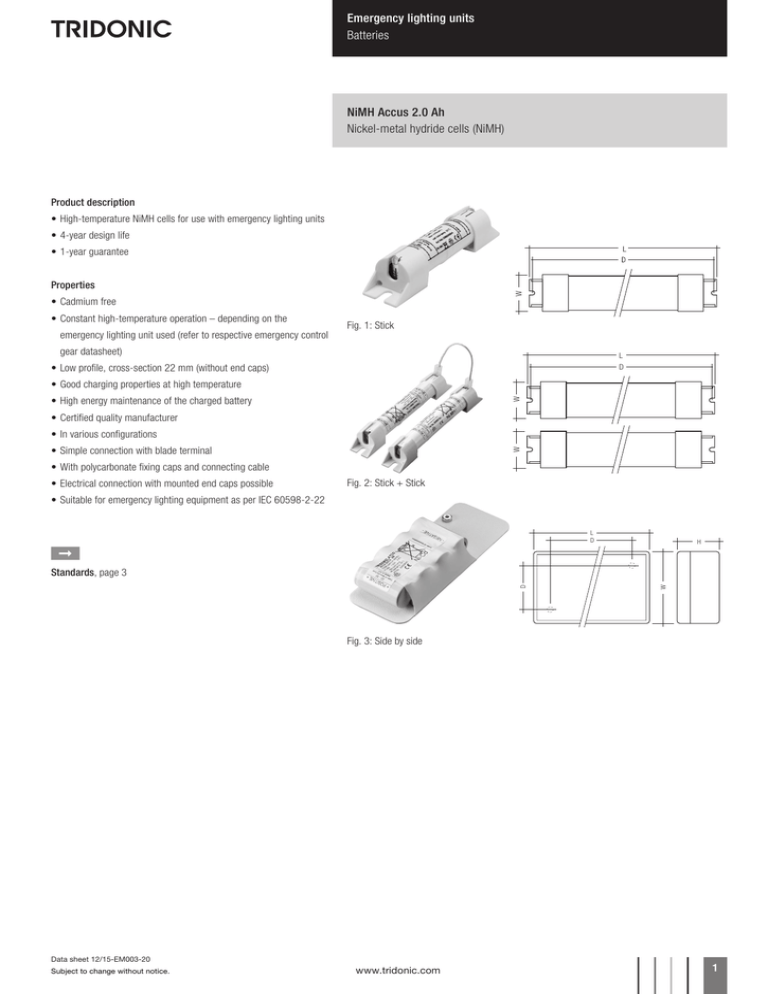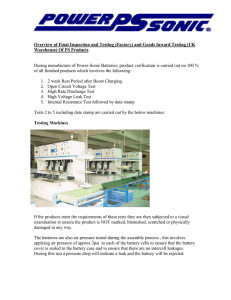Emergency lighting units Batteries NiMH Accus 2.0 Ah Nickel
advertisement

Emergency lighting units Batteries NiMH Accus 2.0 Ah Nickel-metal hydride cells (NiMH) Product description •High-temperature NiMH cells for use with emergency lighting units •4-year design life •1-year guarantee W Properties •Cadmium free •Constant high-temperature operation – depending on the emergency lighting unit used (refer to respective emergency control Fig. 1: Stick gear datasheet) L •Low profile, cross-section 22 mm (without end caps) D •Good charging properties at high temperature W •High energy maintenance of the charged battery •Certified quality manufacturer •In various configurations W •Simple connection with blade terminal •With polycarbonate fixing caps and connecting cable •Electrical connection with mounted end caps possible Fig. 2: Stick + Stick •Suitable for emergency lighting equipment as per IEC 60598-2-22 L D H È W D Standards, page 3 Fig. 3: Side by side Data sheet 12/15-EM003-20 Subject to change without notice. www.tridonic.com 1 Emergency lighting units Batteries Technical data Battery voltage per cell 1.2 V Min. battery casing temp. (design life of 4 years) +5 °C Max. battery casing temp. (design life of 4 years) refer to emergency control gear datasheet Ordering data Articlenumber Number Packaging, Capacity of cells carton Accu-NiMH C 2A 89899755 1x2 2 Ah 5 pc(s). 25 pc(s). 0.123 kg Accu-NiMH C 3A 89899744 1x3 2 Ah 5 pc(s). 25 pc(s). 0.201 kg Accu-NiMH C 4A 89899700 1x4 2 Ah 5 pc(s). 25 pc(s). 0.208 kg Accu-NiMH C 5A 89899703 1x5 2 Ah 5 pc(s). 25 pc(s). 0.261 kg Accu-NiMH C 6A 89899706 1x6 2 Ah 5 pc(s). 25 pc(s). 0.312 kg 89899707 3+3 2 Ah 5 pc(s). 25 pc(s). 0.318 kg 89899704 5x1 2 Ah 5 pc(s). 25 pc(s). 0.276 kg Type Packaging, outer box Weight per pc. NiMH Cs cells - stick, 2 Ah NiMH Cs cells - stick + stick, 2 Ah Accu-NiMH C 6C NiMH Cs cells - side by side, 2 Ah Accu-NiMH C 5B Specific technical data Type Number of cells Capacity Article number Image Length L Hole spacing D Width B Height H NiMH Cs cells - stick, 2 Ah Accu-NiMH C 2A 2 2 Ah 89899755 1 121 mm 109 mm 26 mm 26 mm Accu-NiMH C 3A 3 2 Ah 89899744 1 164 mm 152 mm 26 mm 26 mm Accu-NiMH C 4A 4 2 Ah 89899700 1 206 mm 194 mm 26 mm 26 mm Accu-NiMH C 5A 5 2 Ah 89899703 1 249 mm 237 mm 26 mm 26 mm Accu-NiMH C 6A 6 2 Ah 89899706 1 292 mm 280 mm 26 mm 26 mm 6 2 Ah 89899707 2 164 mm 152 mm 26 mm 26 mm 5 2 Ah 89899704 3 148 mm 40 x 96 mm 54 mm 25 mm NiMH Cs cells - stick + stick, 2 Ah Accu-NiMH C 6C NiMH Cs cells - side by side, 2 Ah Accu-NiMH C 5B Data sheet 12/15-EM003-20 Subject to change without notice. www.tridonic.com 2 Emergency lighting units Batteries Standards The battery cells are designed to comply with the IEC international standard and tested according to the normative permanent charge endurance test described in the IEC 61951-2 standard. This performance is mandatory for use in Emergency Lighting Units to comply with the IEC 60598 2.22. Technical data Accu Capacity Cs Rated minimum capacity Typical capacity Typical weight per cell Cell dimensions: • Diameter • Height 2 Ah 2.2 Ah 60 g 22 mm 42.5 mm Consult individual emergency control gear data sheet for maximum allowable temperatures and allowed number of discharge cycles. Technical data End caps Glow-wire test according to EN 61347-1 with increased temperature of 960 °C passed. Storage •Store batteries within the specified temperature range in low humidity conditions. Optimal storage conditions are: – temperature: +5 ... +25 °C – relative humidity: 65 % ±5 % •Avoid atmosphere with corrosive gas •Disconnect batteries before store or delivery •Avoid storage of discharged batteries •A long term storage in open circuit leads to battery self discharge and deactivation of chemical components. It could be required to charge and discharge the batteries a few times to recover the initial performance. Safety •Do not short-circuit the battery pack – when installing the luminaire make sure sharp edges do not come into contact with cables. •Do not open or damage the battery pack or throw it into a fire. •Protect the battery against moisture and keep away from water. •Do not expose the battery to direct sunlight or excessive heat (see storage conditions). •Transport and store the battery only in its original packaging. •Comply with the transport conditions of the transport company. •Follow the instructions on the safety data sheets. Damage/improper use If the battery is damaged or user incorrectly vapours and liquids may escape from it. If you come into contact with battery fluid wash immediate with water and seek medical assistance if necessary. Installation & commissioning •Activating NiMH batteries When using rechargeable NiMH batteries for emergency lighting following point are essential in order to achieve the specified design life time of the batteries: In order to activate new batteries, 2-3 full charging-discharging are needed to make sure batteries achieve their rated capacity. This activating process is defined by running 2-3 full charging (24 hrs) and discharging (1/2/3 hrs) cycles of the batteries. If this activation process is not conducted the emergency luminaire may not pass the initial duration test. If the first duration test fails, please repeat the test once again after a 24 hour charging period. •Avoidance of excessive cycling During building installations, in many cases, mains supply is not available on a permanent 24-hour basis which then leads to unwanted, uncontrolled excessive battery cycles. This has a very strong effect on the design life time of the battery. Make sure that in such situations, the battery remains disconnected in the luminaire till the mains power supply is stable on a 24-hour basis. It is strongly recommended to refer to the datasheets of Tridonic emergency control gears to avoid excessive cycling. At the same time, make sure that this information is handed over to the installation staff / electrician in order to ensure a proper way of installation and commissioning. •Avoidance of deep-discharge conditions If NiMH batteries or individual cells within a battery pack, are driven into deep discharge state they will not recover after charge / discharge cycles. Therefore it is very important that NiMH batteries are not left connected for long periods in a discharged state. Following options may lead to a deep discharge situation and must be avoided: - Storage periods of rechargeable batteries of over 6 month without recharging the battery packs. - Shipment, storage of assembled emergency luminaires with battery pack connected to the emergency driver. - Long periods of mains-interruptions of more than two weeks, once, the emergency system is installed and the battery pack is connected to the emergency driver. Disposal •Do not dispose of batteries with normal waste. •Comply with local regulations when disposing of batteries. Mechanical details Battery leads • Quantity: 1 red and 1 black • Length: 1,300 mm • Wire type: 0.5 mm² solid conductor • Insulation temperature rating: 90 °C Battery end termination Push on 4.8 mm receptacle to suit battery soade fitted with insulating cover Module end termination 8.0 mm stripped insulation Two-piece batteries are supplied with a 200 mm lead with 4.8 mm receptacles at each end and insulating covers to connect the separate sticks together. Connect two battery sticks in series by connecting plus to minus. Batteries Connection method: 4.8 x 0.5 mm spade tag welded to end of cell. For stick packs this connection is accessible after the battery caps have been fitted. To inhibit inverter operation disconnect the batteries by removing the connector from the battery spade tag. Additional information Additional technical information at www.tridonic.com → Technical Data Guarantee conditions at www.tridonic.com → Services No warranty if battery was opened. Data sheet 12/15-EM003-20 Subject to change without notice. www.tridonic.com 3


